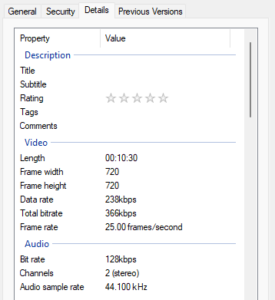Video aspect ratio is a technical term. But it’s a crucial element that can significantly impact the quality and appeal of your video content. It’s a proportional relationship that describes how a video image’s width relates to its height.
With the surge in video streaming, understanding different aspect ratios has become more important. According to a report by Fortune Business Insights, the global video streaming market was valued at $554.33 billion in 2023. It is projected to grow from $671.89 billion in 2024 to $2,486.51 billion by 2032, exhibiting a CAGR of 17.8%. This growth is driven by the increasing adoption of mobile devices and the widespread availability of high-speed internet.
Whether creating YouTube videos, Facebook videos, or content for other popular video streaming platforms, choosing the right aspect ratio can enhance your video quality. This ensures your video displays correctly across different platforms. From standard aspect ratios like 16:9 and 4:3 to the cinematic widescreen, there are various aspect ratios to choose from.
This post will guide you through the maze of aspect ratios, helping you pick the best one for your video content.
What is the Video Aspect Ratio?
The video aspect ratio is a proportional relationship between a video’s width and height. It’s a fundamental concept in video production, affecting both the video quality and how the video displays correctly on different platforms.
For instance, the standard aspect ratio, often seen in older television broadcasts and social media videos, is 4:3. This is also known as the Academy ratio in the film industry. However, the most common aspect ratio today is 16:9. This is the only widescreen aspect ratio used in high-definition television and computer monitors. That’s why it’s recommended for YouTube videos and other popular video streaming platforms.

There are also different aspect ratios, such as the square video (1:1), which is popular on social media platforms, and the vertical video (9:16), which is ideal for mobile devices. The ultra-widescreen, or the 21:9 aspect ratio, is used for cinematic widescreen video content.
Choosing the right aspect ratio depends on your video’s resolution, the platform you’ll upload it to, and your creative vision. For instance, Facebook videos often use the square format, while YouTube video players prefer the 16:9 aspect ratio.
The correct aspect ratio ensures your video posts maintain their original quality and display correctly across various devices, from HD video cameras to mobile screens.
Aspect Ratio vs. Resolution: The Key Differences
Aspect ratio and resolution are two critical terms in video production. The aspect ratio describes the proportional relationship between the video’s width and height. Common aspect ratios include the standard 4:3, the widescreen 16:9, and the ultra widescreen 21:9.
On the other hand, resolution refers to the number of pixels in each dimension a video displays. It directly impacts video quality. Standard-definition (SD), High-definition (HD), and ultra-high-definition (UHD) are common resolutions.
The key difference lies in their roles. Aspect ratio determines the shape of the video frame, while resolution affects the clarity of the video content. For instance, a video with a widescreen aspect ratio will appear wider and less boxy than a standard aspect ratio. However, if the resolution is low, the video quality may be poor despite the correct aspect ratio.
It’s important to choose the right aspect ratio and resolution for your video, considering the platform and device on which it will be viewed. For instance, vertical aspect ratios are ideal for mobile devices and social media videos, while widescreen ratios are better for YouTube videos or high-definition television.
How Aspect Ration Impacts on Viewing Experience
The aspect ratio plays a significant role in how we view videos. Different aspect ratios can significantly impact the viewing experience.
The most common aspect ratios are the standard (4:3), the widescreen (16:9), and the ultra-widescreen (21:9). The 16:9 aspect ratio is the most common for high-definition television and computer monitors. It’s also the only widescreen aspect ratio used for YouTube videos.
On the other hand, the standard aspect ratio is often used for older televisions and video cameras. It’s less common today but still used for specific creative visions.
The aspect ratio you choose should depend on your video content and the platform you’re using. For example, vertical videos with a vertical aspect ratio are perfect for mobile devices and social media platforms like Facebook and Instagram. However, they might need to display correctly on other platforms or devices.
Square videos, with an equal width and height, are also popular on social media platforms. They’re a great option if you want your video to be easily viewable on both desktop and mobile.
In short, choosing the right aspect ratio is crucial for ensuring your video displays correctly and provides the best viewing experience. It’s all about finding the perfect balance between your creative vision, the video’s aspect ratio, and the platform’s video capabilities.
Common Aspect Ratios for Video
The world of video content is filled with various aspect ratios, each serving a unique purpose. Understanding the most common aspect ratios can help you choose the right one for your video and ensure it displays correctly on different platforms. The common aspect ratios for video are explained below, along with their uses.
16:9
The 16:9 aspect ratio is a common aspect ratio used in video production. It has a widescreen aspect ratio, meaning it is wider than tall. This aspect ratio and resolution are often used for high-definition televisions and computer monitors, making it the standard aspect ratio for many video capabilities.

This ratio is also popular on various social media platforms. For example, when you upload videos to YouTube, the video displays correctly in the YouTube video player with this ratio. It’s also the recommended aspect ratio for Facebook videos. This is because most mobile devices and computer monitors use the same aspect ratio, ensuring the video quality is maintained across different platforms.
However, it’s essential to note that not all video content suits this ratio. For instance, a vertical aspect ratio might be more appropriate if your video has a vertical orientation, like many social media videos. The 16:9 aspect ratio is just one of many available.
1:1
The 1:1 video aspect ratio, also known as the square video format, is gaining popularity, particularly on social media platforms. This aspect ratio describes a proportional relationship where the width and height of the video frame are equal, creating a perfect square.
The square format is ideal for mobile devices, as it displays correctly regardless of the device’s vertical or horizontal orientation. This makes it a recommended aspect ratio for social media videos, especially for platforms like Instagram and Facebook.

The 1:1 aspect ratio is not the standard for high-definition televisions or computer monitors, typically using the 16:9 aspect ratio. However, due to its versatility across different platforms, it’s become a popular aspect ratio for social media video posts.
While the 1:1 aspect ratio might not provide the same cinematic widescreen feel as other widescreen aspect ratios, it’s perfect for capturing the viewer’s attention on a crowded social media feed. It also eliminates the need for viewers to rotate their mobile devices or deal with black bars on the screen.
Regarding video quality, the 1:1 aspect ratio can deliver high-definition video content, provided the video resolution is set correctly. So, if you’re looking to upload videos that cater to mobile users on social media, the 1:1 video aspect ratio could be your ideal choice.
4:3
The 4:3 aspect ratio, also known as the standard aspect ratio, is the most common. Older television and computer monitors commonly use this aspect ratio and resolution.
Even today, this ratio is used on various platforms. For instance, some YouTube videos and Facebook videos still use this ratio. It’s also used in video content specifically designed for mobile devices with a vertical orientation.

The 4:3 aspect ratio is not the only widescreen aspect ratio but is one of the best aspect ratios for certain types of video content. For example, it’s the recommended aspect ratio for some social media videos.
3:2
The 3:2 aspect ratio is not the most common, but it’s used in specific scenarios. It’s common in photography and some video cameras. It offers a balance between the standard aspect ratios and widescreen aspect ratios.

This ratio can be ideal for video content intended for various platforms. It’s not the only widescreen aspect ratio, but it can provide high video quality on different platforms, including computer monitors, mobile devices, and popular video streaming platforms.
The 3:2 aspect ratio can also be used for social media videos—platforms like Facebook and YouTube support this ratio.
21:9
The 21:9 video aspect ratio, also known as ultra-widescreen, is one of the different aspect ratios used in video content creation.
This ratio is common for cinematic widescreen presentations, offering a more immersive viewing experience. It’s also the only widescreen aspect ratio that matches the ultra-high definition (UHD) standard, providing superior video quality.

The 21:9 aspect ratio is ideal for video capabilities requiring a broader field of view, such as movie action scenes or panoramic shots in travel vlogs. It’s also the correct aspect ratio for certain computer monitors and high-definition televisions.
However, not all platforms support this aspect ratio. For instance, YouTube and Facebook videos typically use the 16:9 aspect ratio, the most common aspect ratio. When a 21:9 video is played on these platforms, black bars may appear on the top and bottom of the video frame to maintain the original aspect ratio.
Despite these limitations, the 21:9 aspect ratio can be a powerful tool for filmmakers and content creators to realize their creative vision. It offers a unique viewing experience that can set their work apart on popular video streaming platforms.
9:16
The 9:16 video aspect ratio often called the vertical aspect ratio, is popular for video content. This ratio is popular, particularly on mobile devices and social media platforms. This aspect ratio describes a proportional relationship where the video frame is taller than it is wide, ideal for a vertical orientation.

This ratio is commonly used for YouTube videos, Facebook videos, and other social media video posts. It’s one of the most common aspect ratios, alongside the standard 16:9, which is more suited for widescreen video on high-definition televisions and computer monitors.
When you upload videos, choosing the right aspect ratio is essential to ensure your video displays correctly across different platforms. The 9:16 ratio is perfect for mobile viewing, filling the entire screen and improving video quality and viewer experience.
How to Check Video Aspect Ratio
Checking your video’s aspect ratio is a simple process. First, you need to know the common video aspect ratios. These include different aspect ratio options like 4:3, 16:9, and 1:1, which are the most commonly used ratios.
To check, open your video file and look at its properties. Here, you’ll find the video’s resolution, which indicates its aspect ratio. For instance, a resolution of 1280×720 means the aspect ratio is 16:9. This video’s frame width is 720, and its height is 720. So, the aspect ratio is 1:1, which refers to square video format.

Most video editing software lets you set custom aspect ratios when creating a video. The perfect aspect ratio depends on your video’s purpose. For instance, the ideal aspect ratio for video uploads on a streaming platform might differ from that of a cinematic film.
Another popular aspect ratio is the anamorphic format, which uses square pixels for a wider image. Remember, recommended aspect ratios can vary, so it’s best to research the popular aspect ratios for your specific needs.
What is the Best Aspect Ratio for a Video?
The best aspect ratio for a video often depends on the platform where it will be viewed. Common video aspect ratios include 16:9, 4:3, and 1:1. Each aspect ratio has pros and cons. For instance, 16:9 is the most commonly used ratio for video uploads on many streaming platforms. It’s also the ideal aspect ratio for viewing on widescreen devices. On the other hand, a 1:1 ratio, or square pixels, is often the perfect aspect ratio for social media posts. Custom aspect ratios, like the anamorphic format, can also be used for a unique look. When choosing from the popular aspect ratios, consider your audience and the recommended aspect ratios for each platform.
Can You Change the Aspect Ratio of a Video?
Yes, you can change a video’s aspect ratio. It’s a simple process that involves video editing software. This software allows you to adjust the width and height of your video, effectively changing its aspect ratio. However, be careful when doing this, as it can distort your video if not done correctly.
How to Change the Aspect Ratio of a Video
Changing the aspect ratio of a video is a simple process. First, you need a video editing software. There are many available online, both free and paid. You can change the aspect ratio for a video using these tools:
- https://www.onlineconverter.com/resize-video
- https://www.veed.io/tools/resize-video
- https://clideo.com/resize-video
What is the Best Video Ratio in Live Streaming?
The best video ratio for live streaming is key to a quality viewing experience. The most common ratios are 16:9 and 4:3. The 16:9 ratio, often used for YouTube or Twitch, provides a wide view. It’s great for game streaming or showing multiple elements on screen. The 4:3 ratio, though less common now, is still used for some platforms. It gives a more square view, which can be better for close-ups or single-subject streams. The best ratio really depends on your content and platform. Always test different ratios to see what works best for your specific needs.
Final Thoughts
Understanding aspect ratios can significantly improve your video production and streaming experience. It’s all about choosing the right format that fits your content and audience preferences.
Now, you might be wondering how to put this knowledge into practice. That’s where Castr comes in. Castr is a video streaming software designed to make your streaming journey smoother and more efficient. It offers multistreaming that allows you to broadcast your content on multiple platforms at once.
Castr also features an adaptive bitrate, which adjusts video quality in real-time based on the viewer’s internet speed. This ensures a smooth viewing experience for your audience, regardless of their internet connection.
Moreover, Castr guarantees reliable and high-quality streaming with its robust multiple CDN. It’s like having a safety net for your streams, ensuring they reach your audience without hiccups.
Castr is an all-in-one video streaming solution. It’s designed to handle all your streaming needs, from broadcasting to analytics.
So, why give Castr a try? Use your newfound knowledge of aspect ratios and see the difference it makes in your streaming experience. With Castr, you’re not just streaming; you’re creating an unforgettable viewing experience for your audience.







